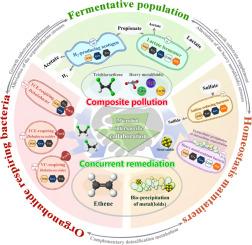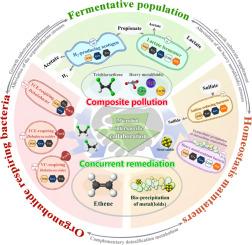硫酸盐驱动微生物协同修复氯乙烯重金属污染
IF 11.4
1区 环境科学与生态学
Q1 ENGINEERING, ENVIRONMENTAL
引用次数: 0
摘要
长期以来,重金属(loid)(HM)复合污染的处理一直是有机卤化物污染场地生物修复的难题。鉴于硫酸盐还原菌(SRB)与有机卤化物发酵菌(OHRB)普遍共生,我们提出了一种硫酸盐改良策略,以实现对三氯乙烯和多种 HMs [50μM的As(III)、Ni(II)、Cu(II)、Pb(II)]的协同修复。相应地,在抑制 HM 的批次中加入 50-75 μM 的硫酸盐,以研究硫酸盐添加剂对生物脱氯的促进作用。脱氯动力学和 MATLAB 建模表明,硫酸盐添加剂全面提高了在 As(III)、Ni(II)、Pb(II) 和混合 HMs 存在下的还原脱氯性能,而在 Cu(II) 暴露下未观察到任何增强。此外,硫酸盐的引入有效地加速了 Ni(II)、Pb(II)、Cu(II) 和 As(III) 的解毒过程,在头三天内的去除率分别达到 76.87%、64.01%、86.37% 和 95.50%。同时,丙酸动态和乙酰生成表明碳源和电子供体供应得到了加强。16S rRNA 基因测序和元基因组分析结果表明,HM 固碳是由 SRB 和抗 HM 菌通过胞外沉淀(金属硫化物)和胞内固碳共同完成的,而它们的贡献取决于共存的特定 HM 物种。这项研究强调了硫酸盐在同时对 HM-有机卤化物复合污染进行生物修复中的关键作用,并为开发具有成本效益的原位生物修复策略提供了启示。本文章由计算机程序翻译,如有差异,请以英文原文为准。


Sulfate-driven microbial collaboration for synergistic remediation of chloroethene-heavy metal pollution
The treatment of heavy metal(loid) (HM) composite pollution has long posed a challenge for the bioremediation of organohalide-contaminated sites. Given the prevalent cohabitation of sulfate-reducing bacteria (SRB) with organohalide-respiring bacteria (OHRB), we proposed a sulfate-amendment strategy to achieve synergistic remediation of trichloroethene and diverse HMs [50μM of As(III), Ni(II), Cu(II), Pb(II)]. Correspondingly, 50–75 μM sulfate was introduced to HM inhibitory batches to investigate the enhancement effect of sulfate amendment on bio-dechlorination. Dechlorination kinetics and MATLAB modeling indicated that sulfate amendment comprehensively improved the reductive dechlorination performance in the presence of As(III), Ni(II), Pb(II) and mixed HMs, while no enhancement was observed under Cu(II) exposure. Additionally, sulfate introduction effectively accelerated the detoxification of Ni(II), Pb(II), Cu(II), and As(III), achieving removal efficiencies of 76.87 %, 64.01 %, 86.37 %, and 95.50 % within the first three days, respectively. Meanwhile, propionate dynamics and acetogenesis indicated enhanced carbon source and e-donor supply. 16S rRNA gene sequencing and metagenomic analysis results demonstrated that HM sequestration was accomplished jointly by SRB and HM-resistant bacteria via extracellular precipitation (metal sulfide) and intracellular sequestration, while their contribution depended on the specific coexisting HM species present. This study highlights the critical role of sulfate in the concurrent bioremediation of HM-organohalide composite contamination and provides insights for developing a cost-effective in-situ bioremediation strategy.
求助全文
通过发布文献求助,成功后即可免费获取论文全文。
去求助
来源期刊

Water Research
环境科学-工程:环境
CiteScore
20.80
自引率
9.40%
发文量
1307
审稿时长
38 days
期刊介绍:
Water Research, along with its open access companion journal Water Research X, serves as a platform for publishing original research papers covering various aspects of the science and technology related to the anthropogenic water cycle, water quality, and its management worldwide. The audience targeted by the journal comprises biologists, chemical engineers, chemists, civil engineers, environmental engineers, limnologists, and microbiologists. The scope of the journal include:
•Treatment processes for water and wastewaters (municipal, agricultural, industrial, and on-site treatment), including resource recovery and residuals management;
•Urban hydrology including sewer systems, stormwater management, and green infrastructure;
•Drinking water treatment and distribution;
•Potable and non-potable water reuse;
•Sanitation, public health, and risk assessment;
•Anaerobic digestion, solid and hazardous waste management, including source characterization and the effects and control of leachates and gaseous emissions;
•Contaminants (chemical, microbial, anthropogenic particles such as nanoparticles or microplastics) and related water quality sensing, monitoring, fate, and assessment;
•Anthropogenic impacts on inland, tidal, coastal and urban waters, focusing on surface and ground waters, and point and non-point sources of pollution;
•Environmental restoration, linked to surface water, groundwater and groundwater remediation;
•Analysis of the interfaces between sediments and water, and between water and atmosphere, focusing specifically on anthropogenic impacts;
•Mathematical modelling, systems analysis, machine learning, and beneficial use of big data related to the anthropogenic water cycle;
•Socio-economic, policy, and regulations studies.
 求助内容:
求助内容: 应助结果提醒方式:
应助结果提醒方式:


